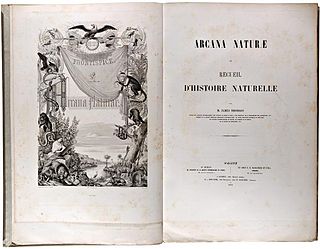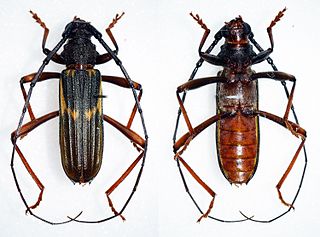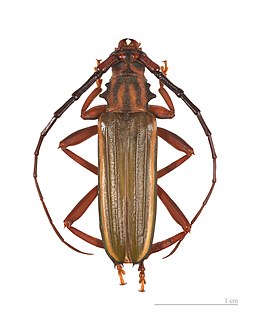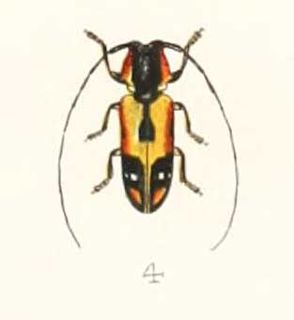
Lamiinae, commonly called flat-faced longhorns, are a subfamily of the longhorn beetle family (Cerambycidae). The subfamily includes over 750 genera, rivaled in diversity within the family only by the subfamily Cerambycinae.

James Livingston Thomson was an American entomologist who specialised in Coleoptera.

Batocera wallacei, common name Wallace's long-horn beetle, is a species of flat-faced longhorn beetle in the subfamily Lamiinae of the family Cerambycidae. The species name honors Alfred Russel Wallace, who discovered this longhorn beetle on the Aru Islands in Indonesia. It was named after him by James Thomson in 1858.

Bothriospilini is a tribe of beetles in the subfamily Cerambycinae. The tribe was proposed in 1950 by Brazilian entomologist Frederico Lane as a member of the new subfamily Bothriospilinae, and with Bothriospila assigned as the type genus. The tribe is morphologically close to the tribe Torneutini, with which it has in common the same shape of the last abdominal segment, which is wide and largely braided in the female, as well as the anterior thigh cavities that are open from behind and the laterally open medial cavity.

Chlorida is a genus of beetles in the family Cerambycidae, containing the following species:

Chlorida cincta is a species of beetle in the family Cerambycidae. It was described by Félix Édouard Guérin-Méneville in 1844. It is known from Mexico, Colombia, and Ecuador.
Chlorida costata is a species of beetle in the family Cerambycidae. It was described by Audinet-Serville in 1834. It is known from southeastern Brazil, Paraguay, Argentina, and Uruguay.

Chlorida denticulata is a species of beetle in the family Cerambycidae. It was described by Buquet in 1860. It's known distribution is in Guyana, French Guiana, and Ecuador. Known host plants include Eperua rubiginosa, Ormosia paraensis, Hevea guianensis.
Chlorida fasciata is a species of beetle in the family Cerambycidae. It was described by Henry Walter Bates in 1870. It is known to occur in Brazil and Peru.

Chlorida festiva is a species of beetle in the family Cerambycidae. It was described by Carl Linnaeus in his landmark 1758 10th edition of Systema Naturae. It is known from southeastern United States, Central America, South America, and the West Indies. Adult males produce (6E,8Z)-6,8-pentadecadienal, an attractant pheromone. In Puerto Rico the larvae are known to be leaf mining pests of mango crops.
Chlorida inexpectata is a species of beetle in the family Cerambycidae. It was described by Ubirajara Martins, Maria Helena Galileo and Francisco Limeira-De-Oliveira in 2011. The species epithet is derived from the Latin inexpectatus. It is known from Brazil.
Chlorida obliqua is a species of beetle in the family Cerambycidae. It was described by Jean Baptiste Lucien Buquet in 1852.
Chlorida spinosa is a species of beetle in the family Cerambycidae. It was described by Per Olof Christopher Aurivillius in 1887. It is known from Colombia, Bolivia and Peru. Adult males produce (6E,8Z)-6,8-pentadecadienal, an attractant pheromone.
Chlorida transversalis is a species of beetle in the family Cerambycidae. It was described by Jean Baptiste Lucien Buquet in 1844. It is known from Colombia.
Glenea anticepunctata is a species of beetle in the family Cerambycidae. It was described by James Thomson in 1857. It is known from Borneo, Sumatra, India and Malaysia.
Nupserha annulata is a species of beetle in the family Cerambycidae. It was described by James Thomson in 1857. The species is reported from Bhutan, India, Nepal and Pakistan.
Tapeina erectifrons is a species of beetle in the family Cerambycidae. It was described by James Thomson in 1857. It is known from Peru, French Guiana, Colombia, Brazil, and Venezuela.
Tapeina transversifrons is a species of beetle in the family Cerambycidae. It was described by James Thomson in 1857. It is known from Honduras, Costa Rica, Nicaragua, Guatemala, Mexico, Belize, Panama, El Salvador, and Venezuela.

Tragocephala castnia is a species of beetle in the family Cerambycidae. It was described by James Thomson in 1857. It has a wide distribution in Africa. It feeds on Theobroma cacao.

Tragocephala mniszechii is a species of beetle in the family Cerambycidae. It was described by James Thomson in 1857. It has a wide distribution in Africa.







